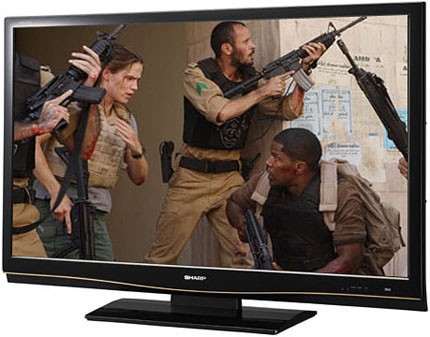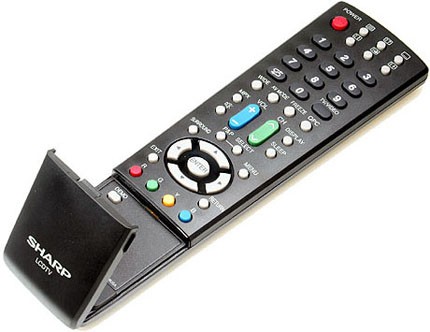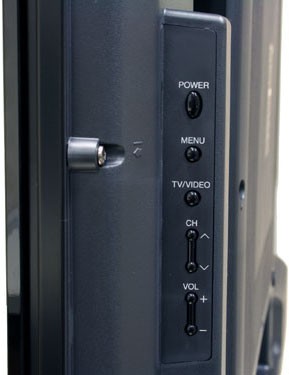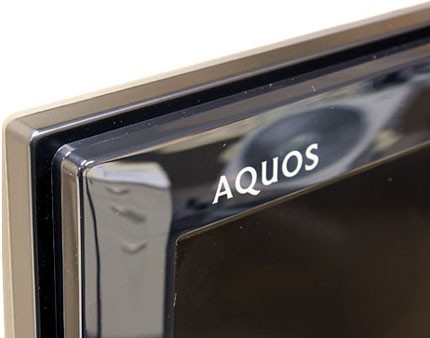 Last year, we were awed by the Aquos G7's impressive tech specs and connectivity options. It's also one of the first to feature six 1080p-compatible ports for optimum external video interface. When combined with a matching 1080p LCD panel and solid HD performance, this earned the series a well-deserved Editors' Choice. Its successor, the A83, has now taken this one step further by embracing 100Hz-scanning technology, a highly sought-after feature relatively new in Asia. This comes at a price though, as you will find out soon enough.
Last year, we were awed by the Aquos G7's impressive tech specs and connectivity options. It's also one of the first to feature six 1080p-compatible ports for optimum external video interface. When combined with a matching 1080p LCD panel and solid HD performance, this earned the series a well-deserved Editors' Choice. Its successor, the A83, has now taken this one step further by embracing 100Hz-scanning technology, a highly sought-after feature relatively new in Asia. This comes at a price though, as you will find out soon enough.Read full review
Design of the Sharp Aquos LC-46A83M
 Call it a change of heart or a cost-cutting measure. Whatever it is, the latest 2007 Aquos, including the LC-46A83M, are deviating from the original Toshiyuki Kita design. Based on a variation of the P7-series, the A83 sports a full frontal glossy treatment which extends all the way to its fixed pedestal stand. To break the set's boxy outlines, its in-housed designers have smoothened out the hard edges with rounded corners. This is in addition to a contrasting shiny silver lining sandwiched between the screen and unobtrusive bottom-mounted speakers.
Call it a change of heart or a cost-cutting measure. Whatever it is, the latest 2007 Aquos, including the LC-46A83M, are deviating from the original Toshiyuki Kita design. Based on a variation of the P7-series, the A83 sports a full frontal glossy treatment which extends all the way to its fixed pedestal stand. To break the set's boxy outlines, its in-housed designers have smoothened out the hard edges with rounded corners. This is in addition to a contrasting shiny silver lining sandwiched between the screen and unobtrusive bottom-mounted speakers.
This is really funny. Why dump a single button underneath a huge flip cover?
Another X factor of this classy beauty is its sleek 95mm-thick cabinet, easily one of the thinnest around. Furthermore, the layout of the onboard controls and side inputs are also just about right. These are stacked on top of one another by the right, within easy reach unlike the recently reviewed LGs. To minimize wall-mounting depth, the jacks on the rear are separately grouped and housed with two recessed panels. These have limited clearance which is a potential strain for thicker cords, though there is a wide detachable clip for cable management.
 Bundled in the package is a no-frills remote controller featuring a matching black finish and integrated flip cover. Speaking of which, this conceals just a single button (duh!) with room for more. On the whole, we had little issue with the keys' responsiveness and tactile feedback. That said, it could have been a lot better if some of the ambiguous pictorial labels were avoided. Same for the input toggle button, clustered with the similarly colored numeric keypad. The latter has smart detection technology which filters out only connected ports for onscreen selection.
Bundled in the package is a no-frills remote controller featuring a matching black finish and integrated flip cover. Speaking of which, this conceals just a single button (duh!) with room for more. On the whole, we had little issue with the keys' responsiveness and tactile feedback. That said, it could have been a lot better if some of the ambiguous pictorial labels were avoided. Same for the input toggle button, clustered with the similarly colored numeric keypad. The latter has smart detection technology which filters out only connected ports for onscreen selection. It’s yet another mixed bag of impressions when it comes to the colorful graphical user interface and software menu. Nested within its five submenus is a pretty healthy collection of settings. Here, you will find all the necessary basic video parameters plus a handful of advanced variants. Missing from the lineup, however, are enthusiast-oriented primary color and grayscale adjustments. Looking on the brighter side, first-time buyers will appreciate a generous offering of seven A/V presets. One of these is permanently locked out from customization.
It’s yet another mixed bag of impressions when it comes to the colorful graphical user interface and software menu. Nested within its five submenus is a pretty healthy collection of settings. Here, you will find all the necessary basic video parameters plus a handful of advanced variants. Missing from the lineup, however, are enthusiast-oriented primary color and grayscale adjustments. Looking on the brighter side, first-time buyers will appreciate a generous offering of seven A/V presets. One of these is permanently locked out from customization.Features of the Sharp Aquos LC-46A83M
 If you're future-proofing your next HDTV purchase, you simply can't go wrong with this LCD's native 1,920 x 1,080-pixel resolution. Illuminated by its proprietary four-wavelength fluorescent backlighting (think richer reds and greens), it is capable of putting out a high 10,000:1 dynamic contrast and 450cd/m2 brightness. Sounds a bit too familiar? That's because they are identical to the tech specs of its predecessor. As a matter of fact, the only improvement here is a blazing-fast 4ms response time with the viewing angle staying put at 176 degrees.
If you're future-proofing your next HDTV purchase, you simply can't go wrong with this LCD's native 1,920 x 1,080-pixel resolution. Illuminated by its proprietary four-wavelength fluorescent backlighting (think richer reds and greens), it is capable of putting out a high 10,000:1 dynamic contrast and 450cd/m2 brightness. Sounds a bit too familiar? That's because they are identical to the tech specs of its predecessor. As a matter of fact, the only improvement here is a blazing-fast 4ms response time with the viewing angle staying put at 176 degrees.
Now you have three HDMIs, one of which is located by the side.
Now before you cry foul, the LC-46A83M does come with a couple of new tricks under its belt. Most notable is its implementation of the picture frame rate-doubling technology or 100/120Hz Fine Motion Advanced. This analyzes each current and successive frame to generate intermittent ones, thus increasing the frame rate of PAL/NTSC video format from standard 50/60 to 100/120Hz. When implemented accurately, it theoretically reduces motion blur and promises sharper visuals--a plus if you are a sports or action movie aficionado.
 To workaround the detrimental effects of room acoustics, there is Audyssey EQ. Possibly a first for TVs, this enhances audio reproduction by compensating the limited response of TV speakers as well as the above-mentioned. It is, however, based on a one-size-fixes-all principle, modeled after a so-called typical room environment. Wrapping up the other key elements of the audio subsystem, we have SRS TruSurround XT, a 30W digital amplifier and four-woofer speaker array. The former is a popular virtual surround sound engine found on many flat panels.
To workaround the detrimental effects of room acoustics, there is Audyssey EQ. Possibly a first for TVs, this enhances audio reproduction by compensating the limited response of TV speakers as well as the above-mentioned. It is, however, based on a one-size-fixes-all principle, modeled after a so-called typical room environment. Wrapping up the other key elements of the audio subsystem, we have SRS TruSurround XT, a 30W digital amplifier and four-woofer speaker array. The former is a popular virtual surround sound engine found on many flat panels.Sharp has taken a rather peculiar approach for the LC-46A83M's suite of A/V jacks. While there are three HDMl terminals (one side, two rear) available onboard, these are non-1080p24-enabled. If you think that's a bad call, wait till you test drive the component-video. These are 1080i only, which is actually a step back from the G7 Aquos. Similarly, DVI was dropped for computer input and you will have to settle with an analog equivalent. Nevertheless, there is digital optical audio output which can channel stereo sound to external home theaters.
 Two sets of component-videos to go, but only 1080i-compatible. (Click here to enlarge image) |  (Click here to enlarge image) |  (Click here to enlarge image) |
Performance of the Sharp Aquos LC-46A83M
Getting the LC-46A83M dialed in via SpyderTV Pro was a walk in the park, paired with a Toshiba HD-XE1, Sony PS3 and Pioneer DV-S969Avi. To get a gauge of its TV broadcast quality, we performed a quick scan and was successfully tuned into a number of MediaCorp stations. The outlines of onscreen subjects exhibited strong sharpness and an extremely low degree of dot crawl. Having said that, subtle details were a little too muffled for our liking, while background noise or video grains were visible on stations with poorer reception.
Moving onto the synthetic Avia test patterns, the Aquos aced through the color decoding convincingly, but had problems differentiating the deepest black. The black crush was also observed during Blade 2's warehouse ninja assault, where some shadow details were lost in some of the dark scenes. This is a pity considering the deep whites and plasma-like blacks garnered on most of our reference DVD clips. We would strongly suggest a quality upscaling DVD player, too, as feeding a 480p feed through HDMI churned out lackluster-soft pictures.
To Sharp's credit, the LC-46A83M did put on a strong showing when supplied with quality HD content. Playing the superbly mastered Casino Royale yielded razor-sharp visuals and rich vibrant colors. This was in addition to the life-like flash tones of Bond and his Asian and African American rivals picked up during the lengthy poker game. Switching over to HQV, the panel passed most tests effortlessly, tackling the various jaggies patterns with almost negligible artifact. The only contention here was strobbing in the Film Resolution Lost test.
We've not forgotten the hype behind the Fine Motion Advanced and tried a variety of film and video materials. There was hardly any visible improvement toggling this function on and off. Nonetheless, street races in PS3 Ridge Racer 7 were rendered in ultra-smooth motion with absolutely no hint of ghosting. Running a 1,400 x 1,050 PC signal off an HP 6910P laptop, the desktop was framed accurately, while text showed up relatively sharp. Performing similarly well was the banding test which was reproduced in fine, subtle color gradation.
True to its reputation, the Audyssey EQ had a positive impact on the audio subsystem sound quality. This produced bassy and clear front and center channel imaging even with SRS TruSurround engaged. However, surround effects were a bit lacking and you will have to crank up the volume (60 percent) to reach reference level. With this Aquos, Sharp has definitely bridged the gap in black-level performance. Taking everything into consideration, it could have been another Editors' Choice candidate, if not for its poor video scaling and input video signal compatibility.

0 comments: